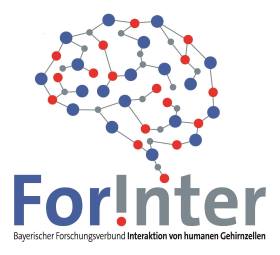ForInter
BAVARIAN RESEARCH ASSOCIATION INTERACTION OF HUMAN BRAIN CELLS

3D human cell culture system for the investigation of gliomas
Conventional cell culture bears limitations to model glioma as it fails to retain the cellular heterogeneity of the parental tumors. In vitro culture conditions select for a uniform cellular phenotype and culture conditions for tumor stem cells and differentiated glioma cells are incompatible. Particularly the interaction of different cell types (glioma stem cells vs. differentiated cells) and the impact of microenvironmental gradients (e.g. regional hypoxic versus normoxic stimuli) is of major importance for a more realistic tumor modeling. Xenograft transplantation models from patient-derived glioma cell cultures in mice in part fulfill these conditions, however also these models in higher passages are prone to selection pressures and limitations by species-specific differences.
Patient-derived 3D cell culture systems are a promising novel tool to study tumor cell interactions in a purely human model. In our subproject we intend to establish different types of 3D organoid models derived from a large collection of molecularly well-characterized primary glioblastoma stem cell lines that are available in our lab. We have performed RNAseq to molecularly subclassify these lines according to the well-described glioblastoma expression subytpes (proneural vs. mesenchymal) that define prognosis and invasive behaviour (Verhaak et al., 2010).
First, we will generate tumor organoids from glioblastoma stem cell cultures and analyze them in terms of the modeled tumor heterogeneity compared to conventional cultures. We will also analyze the cultures for phenotypic differences according to their respective molecular background.
Secondly, we will cocultivate/confront brain tumor stem cells with non-neoplastic cerebral organoids that have been generated within the consortium. The tumor cells will be labeled so that they can be tracked within the organoid to enable an exact investigation of the (purely human) brain/tumor interface modeled in this approach (description of the invasive patterns of the tumor cells within the organoid, comparative RNAseq of non-neoplastic and neoplastic cell fractions before and after they have been confronted).
An important further goal of this project is the generation of a mere autologous model (tumor organoids and generation of iPSC-derived non-neoplastic organoids from the same patients) to overcome interindividual barriers. Also, we will attempt to generate organoids from hard to cultivate cells (IDH-mutated gliomas, oligodendrogliomas, brain metastases).
We are confident that our subproject will generate a number of innovative approaches to model glioblastoma in vitro in a way to more realistically mimic the hierarchy and cellular interactions contained in the parental tumor. We also expect to gain deepened insights into microenvironmental cues defined by the interactions of neoplastic and non-neoplastic cell populations that shape the brain/tumor interface.
Project lead:
Prof. Dr. Markus Riemenschneider
Abteilung für Neuropathologie, Universitätsklinikum Regensburg
Team:



